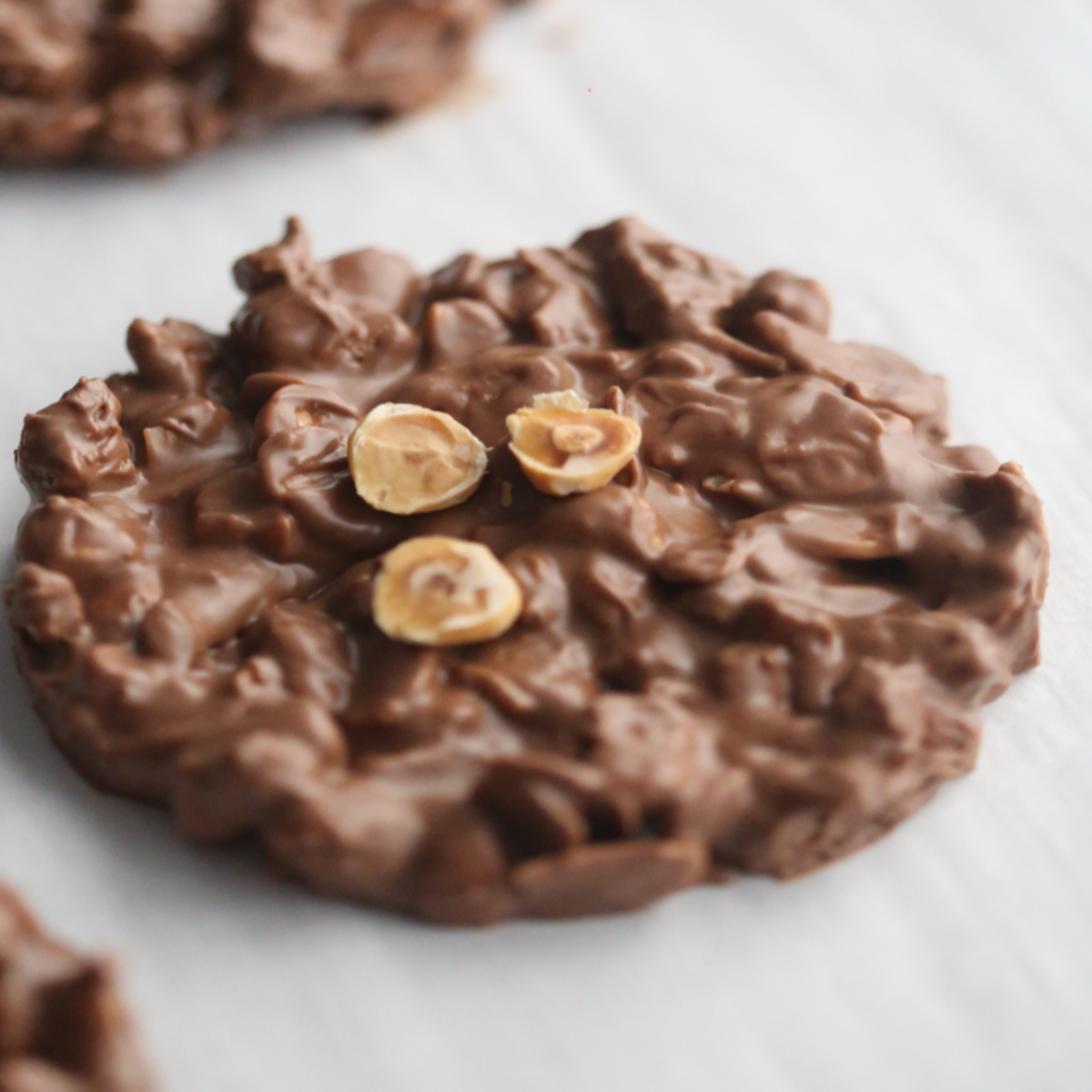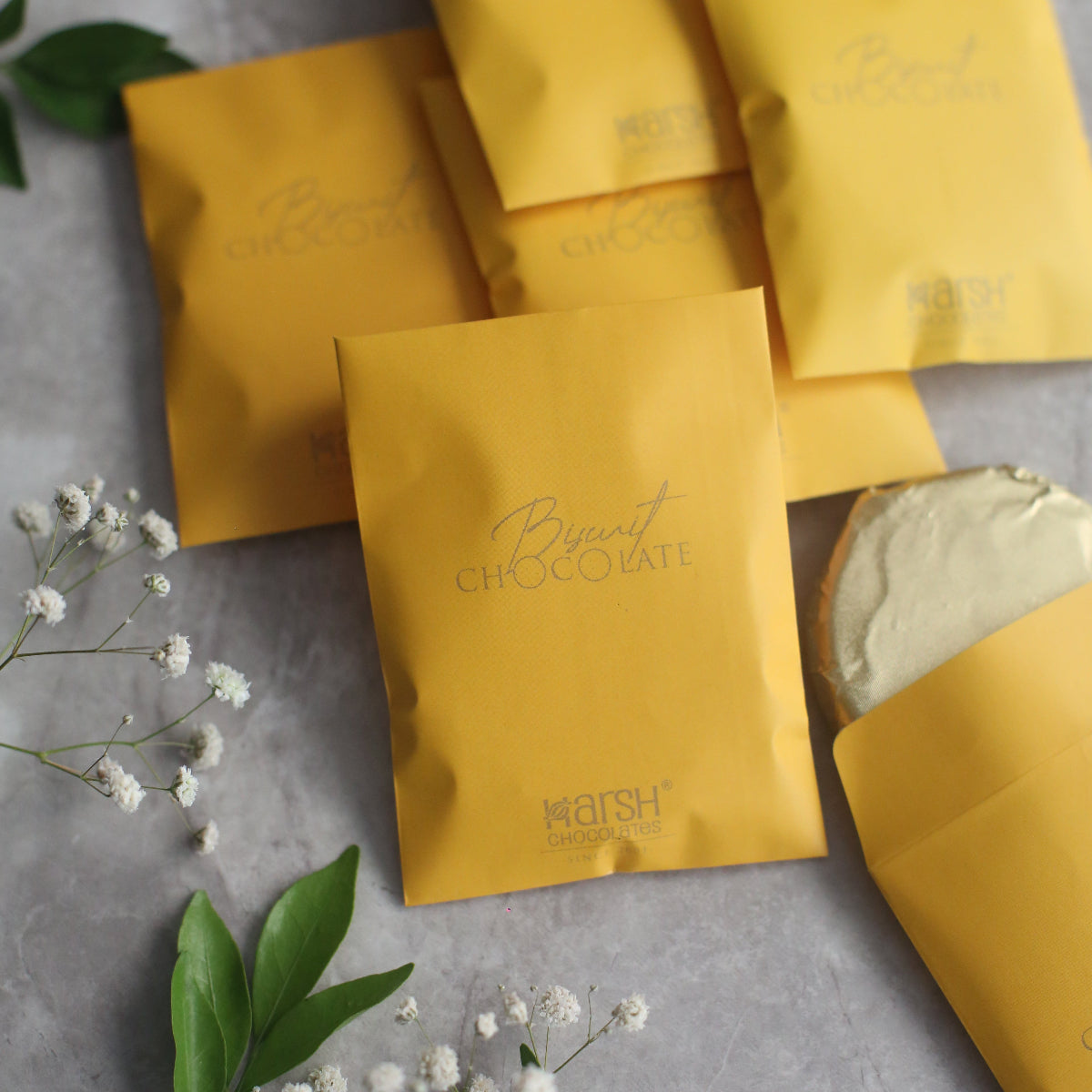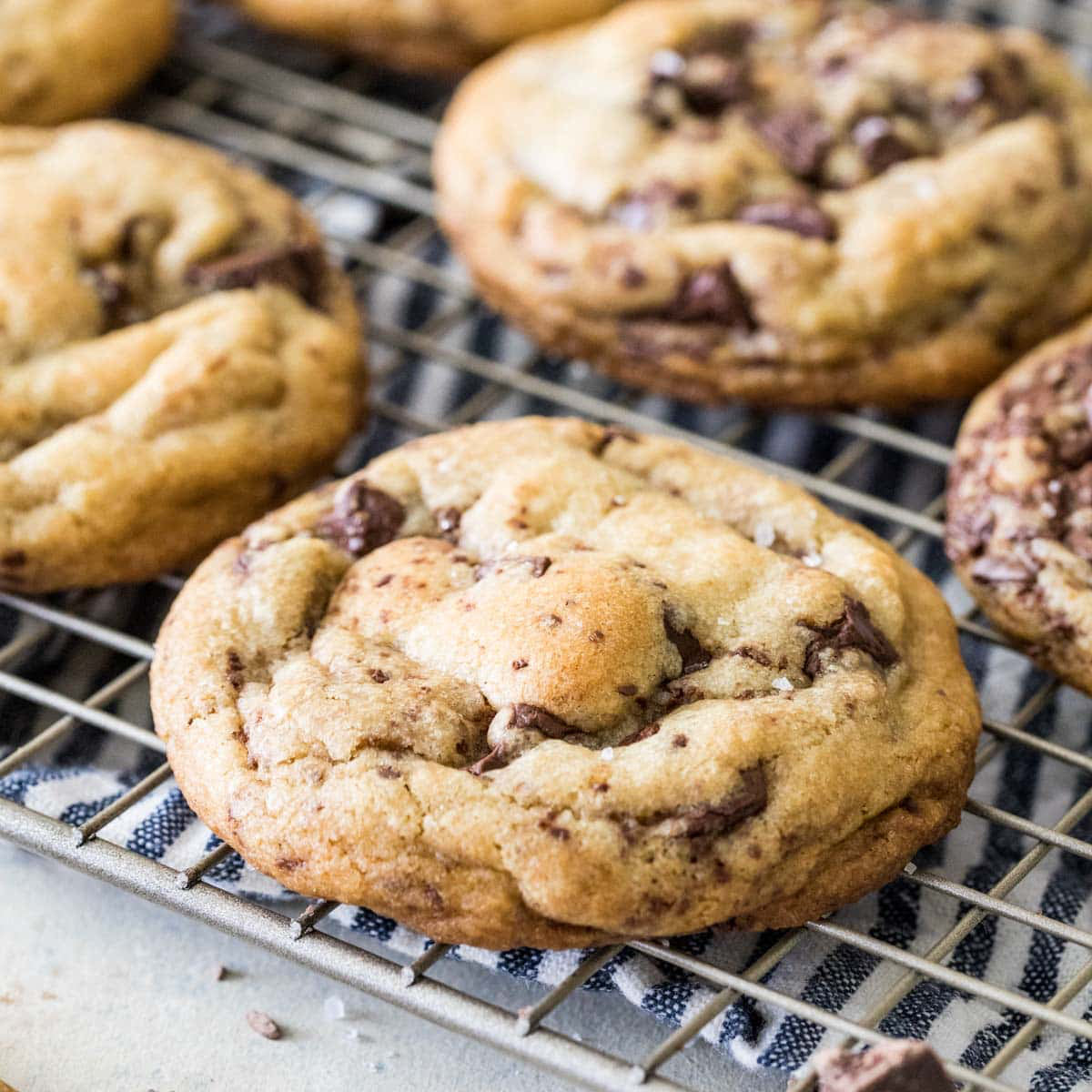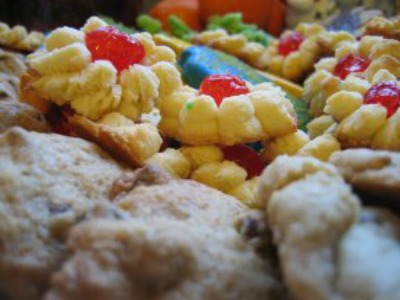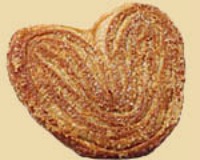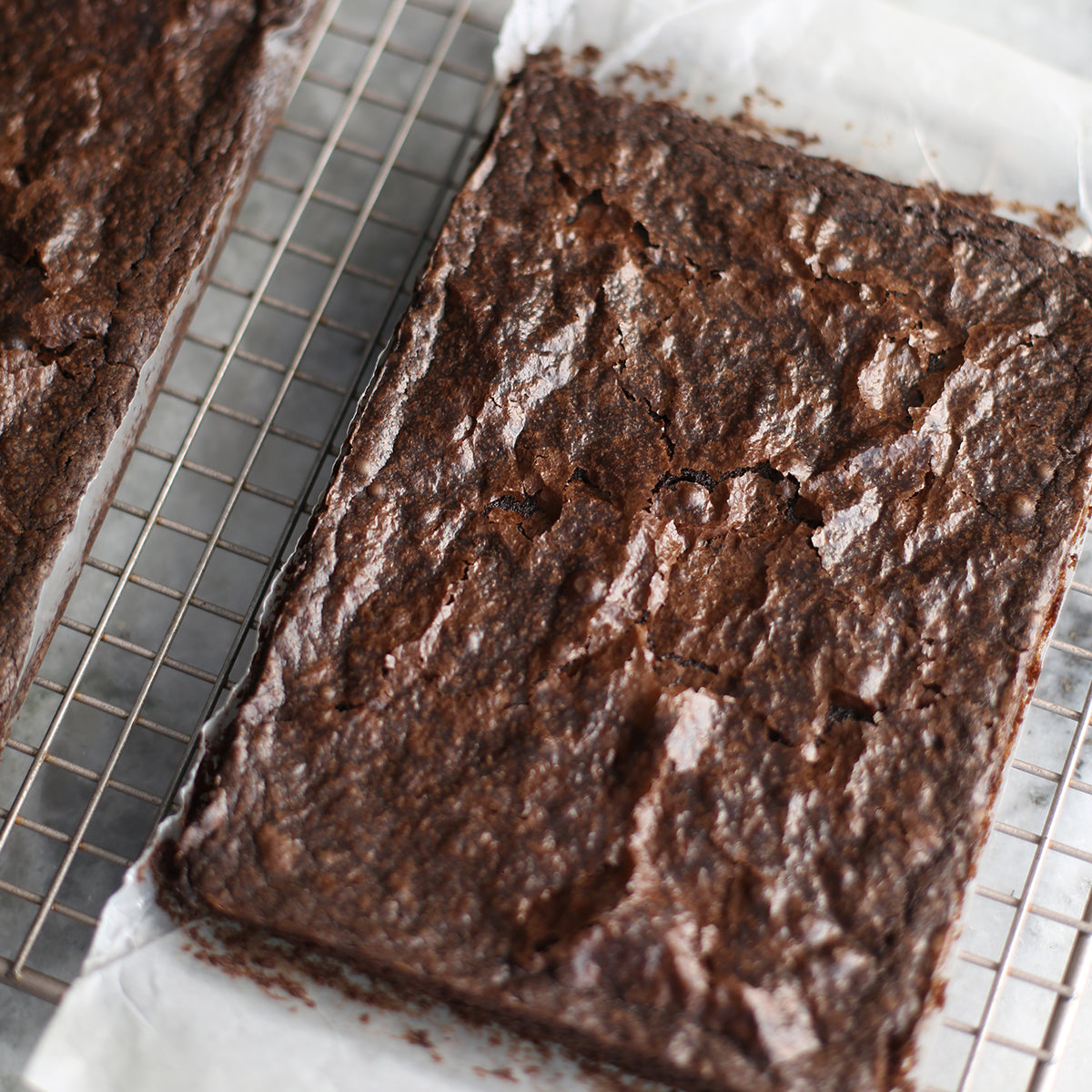What's Cooking America » Cooking Articles » Food History » Cookies History » History of Cookies
After reading all about cookies, be sure to check out What’s Cooking America’s many Cookie Recipes and How To Make Perfect Cookies – Secrets To Making Perfect Cookies.
In America, a cookie is described as a thin, sweet, usually small cake. By definition, a cookie can be any of a variety of hand-held, flour-based sweet cakes, either crisp or soft. Each country has its own word for “cookie.” We know as cookies are called biscuits in England and Australia, in Spain they’re galletas. Germans call them keks or Plzchen for Christmas cookies, and in Italy there are several names to identify various forms of cookies including amarettiand biscotti, and so on. The name cookie is derived from the Dutch word koekje, meaning “small or little cake.” Biscuit comes from the Latin word bis coctum, which means, “twice baked.”
According to culinary historians, the first historic record of cookies was their use as test cakes. A small amount of cake batter was baked to test the oven temperature.
1615 – The English Hus-wife, by Gervase Markham, has two recipes for Jumbles:
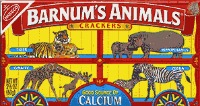 Animal Crackers or Animal Cookies – Information on history of Animal Crackers is from Out of the Cracker Barrel: From Animal Crackers to ZuZu’s, by William Cahn [Simon & Schuster: New York] 1969:
Animal Crackers or Animal Cookies – Information on history of Animal Crackers is from Out of the Cracker Barrel: From Animal Crackers to ZuZu’s, by William Cahn [Simon & Schuster: New York] 1969:
Animal crackers were created and achieved fame many years before the advent of NBC. In the beginning they were just called “Animals.” They were imported from England when “fancy” baked goods first began to be in demand here. In the latter part of the nineteenth century they were manufactured domestically by Herfield & Ducker in Brooklyn as well as Vandeveer & Holmes Biscuit Company in New York. Both firms eventually became pare of the New York Biscuit Company and “Animals” were on of their staples.
When “Animals” were adopted by NBC, their name was changed to “Barnum’s Animals Crackers,” named after P. T. Barnum, showman and circus owner who was so famous during this era. Barnum’s Animals Crackers provided the nation with a new type of animal cracker, produced in a small square box resembling a circus cage with a tape at the top for easy carrying. . . Soon Animal (the s was dropped) Crackers became part of the American scent and of almost very American household.
In total there have been 37 different varieties of animal crackers since 1902. The current 17 varieties of crackers are tigers, cougars, camels, rhinoceros, kangaroos, hippopotami, bison, lions, hyenas, zebras, elephants, sheep, bears, gorillas, monkeys, seals, and giraffes. There are 22 crackers per box.
Animal Crackers became such a part of American life that Christopher Morley (1890-1957), American humorist, playwright, poet, essayist, and editor, wrote the following poem:
Animal Crackers
by Christopher Morley
Animal crackers and cocoa to drink,
That is the finest of suppers I think;
When I’m grown up and can have what I please
I think I shall always insist upon these.
What do YOU choose when you’re offered a treat?
When Mother says, “What would you like best to eat?”
Is it waffles and syrup, or cinnamon toast?
It’s cocoa and animals that I love most!
The kitchen’s the coziest place that I know;
The kettle is singing, the stove is aglow,
And there in the twilight, how jolly to see
The cocoa and animals waiting for me.
Daddy and Mother dine later in state,
With Mary to cook for them, Susan to wait;
But they don’t have nearly as much fun as I
Who eat in the kitchen with Nurse standing by;
And Daddy once said, he would like to be me
Having cocoa and animals once more for tea!
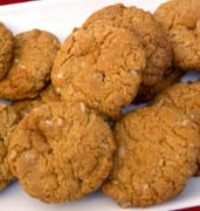 Anzac Biscuit – This is an Australian army biscuit, also known as an Anzac Wafer or an Anzac Tile. They are essentially a hardtack biscuit (see hardtack biscuit below) with a long shelf-life and a substitute for bread. The biscuits are very hard, and soldiers preferred to grind them up and use them as porridge. Today, they are known as Australia’s National Biscuit. ANZAC day is celebrated in Australia and New Zealand on April 25. Around ANZAC Day, these biscuits are also often used by veterans’ organizations to raise funds for the care and welfare of aged war veterans.
Anzac Biscuit – This is an Australian army biscuit, also known as an Anzac Wafer or an Anzac Tile. They are essentially a hardtack biscuit (see hardtack biscuit below) with a long shelf-life and a substitute for bread. The biscuits are very hard, and soldiers preferred to grind them up and use them as porridge. Today, they are known as Australia’s National Biscuit. ANZAC day is celebrated in Australia and New Zealand on April 25. Around ANZAC Day, these biscuits are also often used by veterans’ organizations to raise funds for the care and welfare of aged war veterans.
1815-1832 – The recipe for these biscuits can be traced back to Scotland and the traditional Scottish Oat cakes, also know as bannocks which are thin, flat unleavened oat cakes that are baked on a griddle. During the Scottish immigration to Australia and New Zealand in the early 1800s, it was only natural that the Scottish women brought their recipes for oat cakes with them. They probably had a supply with them on the ships they came in.|
1914-1918 – During World War 1 (1914-1918), the wives, mothers and girlfriends of the Australian and New Zealand soldiers were concerned for the nutritional value of the food being supplied to their men. A food was needed that would survive the long journey by mail to the war front to ANZAC troops serving overseas. The biscuits took two months by sea, with no refrigeration, to reach the soldiers at Gallipoli. On April 25, 1915, the ANZACs (Australian and New Zealand Army Corps) landed at Gallipoli, and suffered the worst defeat in Australian military history. At first the biscuits were called Soldiers’ Biscuits, but after the landing on Gallipoli, they were renamed ANZAC Biscuits. To keep them fresh and crisp they were packed, in old airtight tins.
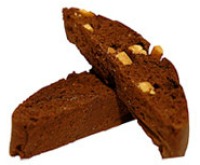 Biscotti (bee-SKAWT-tee) – In Italian, biscotti means, “twice cooked.” The word biscotto is derived from bis (twice) and cotto (cooked). Biscotti is also the generic term for cookies in Italian. The dough is formed into logs and baked until golden brown. The logs are then sliced, and the individual biscotti are baked again to give them their characteristic dryness. The shelf life of biscotti are three to four months without preservatives or additives. Other countries have their version of this cookie – Dutch rusk, French biscotte, and the German zwieback.
Biscotti (bee-SKAWT-tee) – In Italian, biscotti means, “twice cooked.” The word biscotto is derived from bis (twice) and cotto (cooked). Biscotti is also the generic term for cookies in Italian. The dough is formed into logs and baked until golden brown. The logs are then sliced, and the individual biscotti are baked again to give them their characteristic dryness. The shelf life of biscotti are three to four months without preservatives or additives. Other countries have their version of this cookie – Dutch rusk, French biscotte, and the German zwieback.
According to the Arnott Biscuit Company:
One of the earliest records dates biscuits back to second century Rome. Biscuit comes from the Latin word ‘bis coctum’ which means, ‘twice baked’. Back then, ‘biscuits’ were unleavened, hard, thin wafers, which had a low water content. As they contained very little moisture they were the ideal food to store, as they wouldn’t become mouldy quickly.
Early Seaman’s biscuits, also known as hard tack, probably were the first version of biscotti. They were the perfect food for sailors who were at sea for months at a time on long ocean voyages. The biscuits were thoroughly baked to draw out the moisture, becoming a cracker-like food that that was resistant to mold. Biscotti were a favorite of Christopher Columbus who relied on them on his long sea voyage in the 15th century. Historians believe that the first Italian biscotti were first baked in 13th century Tuscany in the in a city called Prato.
1596 – Recipe for a biscuit that is similar to biscotti from the 1596 cookbook called Goode Huswife’s Jewel by Thomas Dawson. This is a recipe for an anise seed biscotti-type confection that gets a drying in the oven, just as modern biscotti (NOTE: Actual Quote):
To make fine bisket bread – Take a pound of fine flower, and a pound of sugar, and mingle it together, a quarter of a pound of Annis-seedes, foure eggs, two or three spoonfulls of rosewater put all these into an earthen panne. And, with a slyce of wood beat it the space of two houres, then fill your moulds half full, your moulds be of tinne, and then lette it into your oven, being so whot as it were for cheat bread and let it stande one houre and an halfe: you must annoint your moulds with butter before you put in your stuffe, and when you will occupie of it, slice it thinne and dry it in the oven, your oven beeing no whotter than you may abide your hand in the bottome.
Check out recipe for Chocolate Biscotti and Honey-Lavender Biscotti.
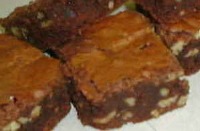 Brownies – A chocolate bar cookie. The name comes from the deep-brown color of the cookie.
Brownies – A chocolate bar cookie. The name comes from the deep-brown color of the cookie.
The origins of the chocolate brownies is uncertain but it is felt that it was probably created by accident, the result of a forgetful cook neglecting to add baking powder to chocolate cake batter. Sears, Roebuck catalog in 1897 published the first known recipe for the brownies, and it quickly became very popular (so popular that a brownie mix was even sold in the catalog). According to some sources, this was a recipe for a molasses candy merely called brownies. The name honored the elfin characters featured in popular books, stories, cartoons and verses at the time by Palmer Cox; the Eastman Kodak Brownie camera was also named after these elves.
According to cookbook author and culinary historian, Jean Anderson, in The American Century Cookbook: The Most Popular Recipes Of The 20th Century, the two earliest published recipes for chocolate brownies appear in Boston-based cookbooks – the first in a 1906 edition of The Boston Cooking-School Cook Book edited by Fannie Merritt Farmer.
The second recipe, appearing in the 1907 Lowney’s Cook Book, written by Maria Willet Howard. Ms. Howard was a protof Fannie Farmer. She added an extra egg and an extra square of chocolate to the Boston Cooking-School recipe, creating a richer, more chocolate brownie. She named the recipe Bangor Brownies.
Check out recipes for Chocolate Truffle Bars, Dieters Beware Brownies, and Ten Plus Brownies.
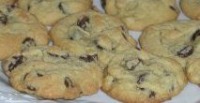 Chocolate Chip Cookie – Today the chocolate chip cookie remains a favorite choice among cookie connoisseurs. The term “toll house” has become a part of the American language.
Chocolate Chip Cookie – Today the chocolate chip cookie remains a favorite choice among cookie connoisseurs. The term “toll house” has become a part of the American language.
1937 – The first chocolate chip cookies was invented in 1937 by Ruth Graves Wakefield (1905-1977), of Whitman, Massachusetts, who ran the Toll House Restaurant. The Toll House Restaurant site was once a real toll house built in 1709, where stage coach passengers ate a meal while horses were changed and a toll was taken for use of the highway between Boston and New Bedford, a prosperous whaling town. The Wakefields sold the restaurant in 1966. It burned down on New Year’s Eve in 1984.
One of Ruth’s favorite recipes was an old recipe for “Butter Drop Do” cookies that dated back to colonial times. The recipe called for the use of baker’s chocolate. One day Ruth found herself without a needed ingredient. Having a bar of semisweet chocolate on hand, she chopped it into pieces and stirred the chunks of chocolate into the cookie dough. She assumed that the chocolate would melt and spread throughout each cookie. Instead the chocolate bits held their shape and created a sensation. She called her new creation the Toll House Crunch Cookies. The Toll House Crunch Cookies became very popular with guests at the inn, and soon her recipe was published in a Boston newspaper, as well as other papers in the New England area. Word of the cookie spread and it became popular.
1939 – This cookie became known nationally when Betty Crocker used it in her radio series on “Famous Foods From Famous Eating Places.” Ruth approached the Nestle company and together, they reached an agreement that allowed Nestle to print what would become the Toll House Cookie recipe on the wrapper of the Semi-Sweet Chocolate Bar. The company developed a scored semisweet chocolate bar with a small cutting implement so that making the chocolate chunks would be easier. According to the story, part of this agreement included supplying Ruth with all of the chocolate she could use to make her delicious cookies for the rest of her life.
1940s – Ruth sold all legal rights to the use of the Toll House trademark to Nestle. On August 25, 1983, the Nestle Company lost its exclusive right to the trademark in federal court. Toll house is now a descriptive term for a cookie.
1997 – A third grade class from Somerset, Massachusetts proposed that the chocolate chip cookie be designated the official cookie of the Commonwealth. The chocolate chip cookie was designated the official cookie of the Commonwealth on July 9, 1997 under the General Laws of Massachusetts.
1996, 1999, and 2003 –
- A group of fourth-grade students at Caln Elementary School in Coatesville introduced a resolution to designate the chocolate chip cookie as the official state cookie of the Commonwealth of Pennsylvania in 1996.
- Senate Bill 271 was introduced on February 1, 1999 to designate and adopt the chocolate chip cookie as the official cookie of the Commonwealth of Pennsylvania. The House is supporting the Nazareth sugar cookie, in a bill sponsored by eight representatives, including Moon Township’s state Rep. and Senator-elect John Pippy.
- Another Senate Bill 320 was introduced by Thompson, Helfrick, M. White, Greenleaf, Rafferty, and C. Williams on February 13, 2003 to designate and adopt the chocolate chip cookie asthe official cookie of the Commonwealth of Pennsylvania. The House and Senate have been in disagreement or debate since these bills were introduced. The bills have been tabled.
Check out recipe for Chocolate Chip Cookies.
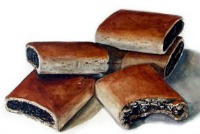 Fig Newton – There are two claims on who invented the Fig Newton Cookies:
Fig Newton – There are two claims on who invented the Fig Newton Cookies:
1892 – The Nabisco Company has maintained that the Fig Newton was invented in 1891 by Philadelphia inventor, James Henry Mitchell. Mitchell is said to have invented the duplex dough-sheeting machines and funnels that made the jam-filled cookies possible. This machine was patented in January of 1892. The cookies were named for Newton, MA. Information on history of Animal Crackers is from Out of the Cracker Barrel: From Animal Crackers to ZuZu’s, by William Cahn [Simon & Schuster: New York] 1969:
In 1892 Mitchell applied for a patent for his new machine, which was granted. Although he had no name for his ‘pie,’ he thought the idea might be of value in commercial baking. So in 1892 he persuaded officials of the Kennedy Biscuit Works, which had recently become affiliated with the New York Biscuit Company, to try out his new machine, which he shipped to Cambridgeport. Mitchell personally installed the machine and supervised its functioning. The professional bakers tasted the final result, found it good and went away impressed. But promotion could not start until a name was selected. The exciting new product of the Mitchell machine needed some such name. Later an assistant to James Hazen, manager of the Cambridgeport bakery, recalled, “The name was taken from the name of the town Newton-a suburb of Boston.” When the name was selected for this new product, it reflected a practice–by Mr. Hazen, who was manager of this plant–of using the names of towns and cities in the vicinity of Boston.
1899 – The website of Historic Roser Park, located inSt Petersburg, Florida claims that Charles Martin Roser (1864-1937), also known as C. M. Roser had a cookie and candy manufacturing company that made Fig Newton Cookies. Legend has it that Roser sold Nabisco the rights to his fig cookies for 1 million dollars, the modern equivalent of about 19 million. To this date, no information has been found to back up this claim.
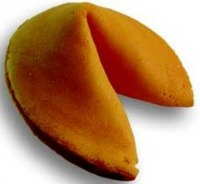 Fortune Cookie – A tasty Chinese-American wafer cookie with a piece of paper inside with a “fortune” written on it.
Fortune Cookie – A tasty Chinese-American wafer cookie with a piece of paper inside with a “fortune” written on it.
Some historians think that the inspiration for Fortune Cookies come from the 12th and 13th centuries when Chinese soldiers slipped rice paper messages into mooncakes to help coordinate their defense against Mongolian invaders. According to legend, the Mongolians had no taste for lotus nut paste. Because of this, the Chinese hid the message containing the date of the uprising and the instructions coordinating the uprising in the middle of their Moon Cakes (replacing the yolk with secret messages). Patriotic revolutionary, Chu Yuan Chang took on the disguise of a Taoist priest and entered occupied walled cities handing out Moon Cakes. These were the instructions to coordinate the uprising which successfully formed the basis of the Ming Dynasty.
It is also a Chinese custom when children are born for the families to send out cake rolls with a message inside announcing the birth of the child. For almost 40 years, the fortune cookies were made using chopsticks.
The messages in the first fortune cookies were simple proverbs or bits of Scripture. By the 1930s, English variations on Confucian logic crept in. Some fortune writers took an American slant, lifting bits from Poor Richard’s Almanac. Today, the fortune these cookies carry can contain messages from Biblical verses, romantic messages, corporate messages, and many more.
1900s – Makota Hagiwara, a landscape architect and caretaker of the Japanese Tea Gardens from the early 1900’s until the outbreak of World War II, made Fortune Cookies in Los Angeles in the early 1900s. Using a Japanese rice cookie called “tsjiura sembei”, he created cookies bearing thank you notes, which helped him in a dispute with the city’s mayor. He displayed his creation at the 1915 Panama-Pacific Exhibition held in San Francisco. The Court of Historical Reviews and Appeals, a San Francisco mock court, ruled that San Francisco is the rightful “fortune cookie capital of the world” in 1983.
1920 – Another story says that a Cantonese immigrant, David Jung (a Los Angeles baker) began making cookies with thin slips of paper inside sometime around 1920. Jung handed out these cookies, which contained words of encouragement, to the poor and homeless people on the streets. He later founded the Hong Kong Noodle Company and produced cookies with fortunes inside.
1960 – Edward Louie, owner of the Lotus Fortune Cookie Company in San Francisco, invented a machine that could fold the cookies in half a lot faster. It is a matter of debate as to where in American these cookies were first made.
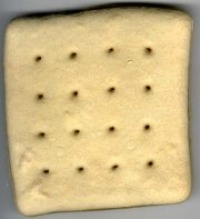 Hardtack – A hard square biscuit or cracker that is made with flour and water only (unleavened and unsalted bread). Also called pilot biscuit, pilot bread, sea biscuit, and ship biscuit. Since it’s very dry, it can be stored for years without refrigeration. People can live for quite a while on just bread and water. Hardtack is eaten by itself, dipped in coffee, or crumbled into soups. Inexpensive, stable, and easy to transport, hardtack was a staple in military life throughout most of our history. It was also the most convenient food for soldiers, explorers, and pioneers.
Hardtack – A hard square biscuit or cracker that is made with flour and water only (unleavened and unsalted bread). Also called pilot biscuit, pilot bread, sea biscuit, and ship biscuit. Since it’s very dry, it can be stored for years without refrigeration. People can live for quite a while on just bread and water. Hardtack is eaten by itself, dipped in coffee, or crumbled into soups. Inexpensive, stable, and easy to transport, hardtack was a staple in military life throughout most of our history. It was also the most convenient food for soldiers, explorers, and pioneers.
Dandy funk – Also called Danderfunk. A pudding made by sailors using crumbled hardtack, fat, and molasses.
History is not clear when people first began to make hardtack, but it’s quite probable that its history began in prehistory. Prehistoric people boiled grains; they cooked grains and added vegetables and herbs to the mixture; and sometimes they ground it into a powder, mixed it with water, and dried it on a hot stone. Six thousand year-old unleavened biscuits have been found in Switzerland.
Hardtack was a part of the staple diet of English and American sailors for many centuries. Christopher Columbus took unleavened bread with him on his journeys. Sailors referred to it as sea biscuit, sea bread, ship biscuit, Midshipman’s nuts, and pilot bread. During the early settlement of North America, the exploration of the continent, the American Revolution, and on through the American Civil War, armies were kept alive with hardtack.
During the American Civil War (1861-1865), a soldier in the army, both north and south was usually issued one half pound of beans or peas, bacon, pickled beef, compressed mixed vegetables and one pound of hard tack. Too hard to be eaten whole, it was generally broken up with a rock or rifle butt, placed in the cheek pocket and softened with saliva enough to be chewed and swallowed. The hardtack was also soaked in water and then fried in bacon grease to soften it. The soldiers called the biscuits “sheet iron crackers”, “teeth dullers”, or “worm castles” in references to the weevils and maggots all too often found in the hardtack boxes. It appears that it was first called hardtack by the Union Army of the Potomac; although the name spread to other units, it was generally referred to as hard bread by the armies of the West.
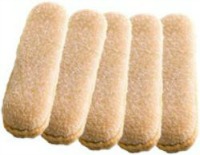 Ladyfingers– Oval-shaped cookies or cakes that are also known around the world as Boudoir biscuits, sponge biscuits, sponge fingers, Naples biscuits, Savoy biscuits (Savoiardi) and biscuits a la cuiller.
Ladyfingers– Oval-shaped cookies or cakes that are also known around the world as Boudoir biscuits, sponge biscuits, sponge fingers, Naples biscuits, Savoy biscuits (Savoiardi) and biscuits a la cuiller.
11th Century – The recipe, which has changed little in nine hundred years, dates from the House of Savoy in the eleventh century France. Historians seem to think that the recipe was carried throughout Europe by the marriages of the descendents of Bertha of Savoy (1051-1081) to the royalty of Europe.
18th Century – Folklore has it that Czar Peter the Great of Russia (1689-1725) and his wife, the peasant empress Catherine, so enjoyed Ladyfingers when visiting Louis XV of France (1774), that they purchased the Baker and sent him immediately to Saint Petersburg.
1901 – Specialty Bakers Inc., a small bakery company on the banks of the Susquehanna River in Marysville, Pennsylvania, is known as “The Ladyfinger Specialist.” Virtually all the commercially available Ladyfingers in America have been baked by Specialty Bakers since 1901.
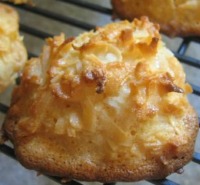 Macaroon (mak-uh-ROON) – A small round cookie that has a crisp crust and a soft interior. It may be made from almonds, though coconut is common in the U.S. They may also be flavored with coffee, chocolate, or spices.
Macaroon (mak-uh-ROON) – A small round cookie that has a crisp crust and a soft interior. It may be made from almonds, though coconut is common in the U.S. They may also be flavored with coffee, chocolate, or spices.
1792 – They originated in an Italian Monastery around 1792. During the French Revolution (1789-1799), the sequestration of monasteries in southern Europe were heavy blows to the Carmelites Order. The Carmelite nuns to pay for their housing when they needed asylum during the French Revolution baked these cookies. According to some historians, the Carmelite nuns followed the principle: “Almonds are good for girls who do not eat meat.” During the Revolution, two nuns who hid in the village called Nancy, made and sold macaroons. They became known as the “Macaroon Sisters.”
In 1799, the Carmetlite community, as did the whole Catholic Church and especially religious life, began experiencing a series of difficulties and persecution that lasted throughout the19th century. In those years, throughout the succession of historical events, the nuns, constantly harassed, had to struggle and suffer much so that their monastery would not be suppressed or they themselves expelled from it. Today in the city Antequera, Spain, the order sells pastries and bread to the public, but are not allowed visual contact with the outside world, so the transactions are carried out by means of a bell-rope and a revolving wooden door.
Amaretti (ah-mah-REHT-tee) – An Italian almond macaroon cookie. The Italian word “amaro” means “bitter,” and the literal translation of “amaretti” is “the little bitter ones.” They are called amaretti because they are flavored with bitter almonds. Francesco Moriodo, pastry chef at the court of Savoy, created them in the mid-17th century.
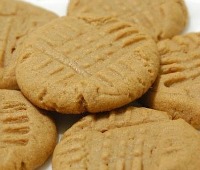 Peanut Butter Cookies – Hand rolled dough containing peanut butter. Dough is rolled into a ball and then flattened with the tins of a fork.
Peanut Butter Cookies – Hand rolled dough containing peanut butter. Dough is rolled into a ball and then flattened with the tins of a fork.
George Washington Carver (1864-1943), an African-American educator, botanist and scientist from Alabama’s Tuskegee Institute, began to promote the peanut as a replacement for the cotton crop which had been destroyed by the boil weevil. By 1903, he developed hundreds of uses for peanuts in recipes. In his 1916 Research Bulletin called How to Grow the Peanut and 105 Ways of Preparing it for Human Consumption, he has a three recipes for peanut cookies calling for crushed/chopped peanuts as an ingredient.
In 1922, Joseph L. Rosefield began selling a number of brands of peanut butter in California. These peanut butters were churned like butter so they were smoother than the gritty peanut butters of the day. He soon received the first patent for a shelf-stable peanut butter which would stay fresh for up to a year because the oil didn’t separate from the peanut butter. One of the first companies to adopt this new process was Swift & Company for its E.K. Pond peanut butter – renamed Peter Pan in 1928. In 1932, Rosefield had a dispute with Peter Pan and began producing peanut butter under the Skippy label the following year. Rosefield created the first crunchy style peanut butter two years later by adding chopped peanuts into creamy peanut butter at the end of the manufacturing process.
It is not until the early 1930s that peanut butter was listed as an ingredient in cookies. The 1933 edition of Pillsbury’s Balanced Recipes by Mary Ellis Ames, Director of the Pillsbury Cooking Service, contains a recipe for Peanut Butter Balls. It instructs the cook to roll the dough into balls and press them down with the tines of a fork. This practice is still common in America today.
Check out recipe for Peanut Butter Cookies.
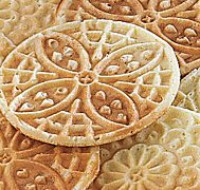 Pizzelle (pit-sell)- Pizzelle’s come from Italy. Pizzelle are also known as Italian wafer cookies and there are various ways which to spell pizzelle such as piazelle, piazella, pizzele and pizelle. The name comes from the Italian word pizze for round and flat. Many different cultures have adapted this cookie and re-named it accordingly. In Scandinavia they are also known as Lukken and the Krumcake is baked using a similar iron as the pizzelle.
Pizzelle (pit-sell)- Pizzelle’s come from Italy. Pizzelle are also known as Italian wafer cookies and there are various ways which to spell pizzelle such as piazelle, piazella, pizzele and pizelle. The name comes from the Italian word pizze for round and flat. Many different cultures have adapted this cookie and re-named it accordingly. In Scandinavia they are also known as Lukken and the Krumcake is baked using a similar iron as the pizzelle.
In some parts of Italy, the irons would be made with family crests on them which would be passed down to each generation.
Pizzelles are the oldest known cookie and originated in the mid-section of Italy. They were made many years ago for the “Festival of the Snakes” also known as the “Feast Day of San Domenico” in the village of Colcullo in the Italian region of Abruzzo. This village in Italy that was once overrun with snakes, and they were chased out. Afterwards the village celebrated with pizzelle. Sweet bread pancakes, know as pizzelles, are sold in an auction, to receive the offers of the faithful: they will be on show during the procession with the statue of the saint enveloped by live snakes.
According to an article from the Lonely Planet Publications on the Festival of the Snakes:
Legend has it that the mountainous and bucolic area around Abruzzo was once so infested by snakes that life tended to the short, sharp and brutal rather than the long and cheerful. The local shepherds, back in 700 BC, appealed to Apollo for help. His advice was to capture the snakes, domesticate them by draping them around his statue and then release them into the bush again.
Curiously, this seemed to work and the ritual has been replayed ever since. Somewhere along the way, however, the fickle mortals dumped the old Greek gods for the newish Christian gods and indulged in a bit of historical revisionism. Apollo became Saint Domenica and a few touches of modernity, like fireworks, were added to the ritual.
Celebrations begin on St Joseph’s Day, 19 March, when the first snakes of the season are netted and caged. Two months later, on the first Thursday in May, the village is stirred by an 8am revelry call of fireworks, followed by a traditional mass. After the mass, the statue of Saint Domenica is hauled through the streets of Colcullo, where villagers drape the captured serpents, boa-like, around the stone neck of Saint Domenica.
This ritual and the procession is usually accompanied by a noisy band of villagers, barking dogs and merry-makers. At the edge of the village the squirming mass is released back into the bush and the villagers, so it is said, are immune from snake bites for another year.
Pizzelles is similar in meaning to Pizza. In Salle, in the Abruzzi region of Italy, there is a festival, which takes place in which pizzelle plays a large role. The feast is held in July to honor Beato Roberto a twelfth-century monk. When the feast begins, people bring food to the town square and some people attach pizzelle to tree branches and proceed down the street with them.”
Pizzelle makers are typically called irons, because the first ones were just that — irons that were forged by blacksmiths. Women would go to local blacksmiths, and the blacksmiths would make them and work in a design for them.
In some parts of Italy, the irons would be made with family crests on them which would be passed down to each generation.
To many Italians, there is no feast without pizzelles.
Check out the recipe for Italian Pizzelles – Italian Wafer Cookie Recipe.
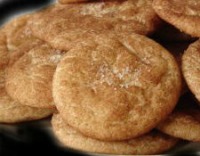 Snickerdoodles – Traditional snickerdoodles are coated with cinnamon sugar before being baked.
Snickerdoodles – Traditional snickerdoodles are coated with cinnamon sugar before being baked.
Cookies as we know them in America were originally brought to the United States by our English, Scottish, and Dutch immigrants. Earlier names for cookies such as Snickerdoodles and Cry Babies originated with the New England states. Even with its early history, cookies did not become popular until about a hundred years ago.
In earlier American cookbooks, cookies were given no space of their own but were listed at the end of the cake chapter. They were called by such names as “jumbles,” “Plunkets,” and “Cry Babies.” The names were extremely puzzling and whimsical. New England cooks seem to have had a penchant for giving odd names to their dishes, apparently for no other reason than the fun of saying them. Snickerdoodles comes from a tradition of this sort that includes Graham Jakes, Jolly Boys, Branble, Tangle Breeches, and Kinkawoodles.
Check out the recipe for Snickerdoodles.
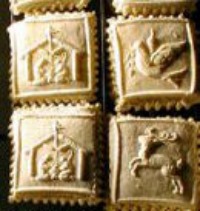 Springerle (SPRING-uhr-lee) – These have been and still are traditional Christmas cookies in Bavaria and Austria for centuries. Springerle are white, anise-flavored cookies, made from a simple egg-flour-sugar dough. Usually rectangular or circular in shape, they have a picture or design stamped on the top. The images are imprinted with specially carved rolling pins or flat molds (Springerle presses, or boards). After the cookies are baked, the designs are sometimes enhanced with edible food colors–or with tempera or acrylic paints, if the cookies are to be used as decorations. Hartshorn is the traditional leavening (it is an ammonia compound).
Springerle (SPRING-uhr-lee) – These have been and still are traditional Christmas cookies in Bavaria and Austria for centuries. Springerle are white, anise-flavored cookies, made from a simple egg-flour-sugar dough. Usually rectangular or circular in shape, they have a picture or design stamped on the top. The images are imprinted with specially carved rolling pins or flat molds (Springerle presses, or boards). After the cookies are baked, the designs are sometimes enhanced with edible food colors–or with tempera or acrylic paints, if the cookies are to be used as decorations. Hartshorn is the traditional leavening (it is an ammonia compound).
These cookies are made with a leavening agent called ammonium carbonate, or baking ammonia. Ammonium carbonate is a byproduct of hartshorn, a substance extracted from deer antlers (harts horn). This leavener is the precursor of today’s baking powder and baking soda. If you sample the dough of these cookies, you will be able to taste the ammonia, but it will completely evaporate out when the cookies are baked.
The name Springerle comes from an old German dialect and means “little knight” or “jumping horse.” Historians trace these cookies back to the Julfest, a midwinter celebration of pagan Germanic tribes. Julfest ceremonies included the sacrificing of animals to the gods, in hope that such offerings would bring a mild winter and an early spring. Poor people who could not afford to kill any of their animals gave token sacrifices in the form of animal-shaped breads and cookies. Vestiges of these pagan practices survive in the baking of shaped-and-stamped German Christmas cookies such as Lebkuchen, Spekulatius, Frankfurter Brenten, and Springerle.
Scenes from the Bible were some of the earliest images portrayed on the springerle molds and were used to educate those who couldn’t read or write. Eventually, other scenes were carved and the cookies soon reflected images of holidays, events, and scenes from every day life. The cookies were also used to celebrate births, weddings, and used as betrothal tokens. Exchanging springerle during the holidays was a common practice very much like we exchange cards today.
The oldest known springerle mold from Switzerland was carved from wood in the 14th century. This round shaped mold pictures the Easter lamb, and originates from the St. Katharine monastery in Will St. Gallen. It is now in the collection of the Swiss national museum in Zurich, Switzerland.
Check out the German Springerle Cookie Recipe.
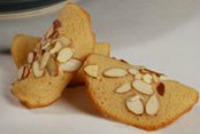 Tuile (TWEEl) – French for “tile.” A tuile is a thin, crisp cookie that is placed over a rounded object (like a rolling pin or a mold) while still hot from the oven. Once cooled and stiff, the cookie resembles a curved roof tile.
Tuile (TWEEl) – French for “tile.” A tuile is a thin, crisp cookie that is placed over a rounded object (like a rolling pin or a mold) while still hot from the oven. Once cooled and stiff, the cookie resembles a curved roof tile.
The classic tuile is made with crushed almonds but the cookie can also be flavored with orange, lemon, vanilla or other nuts. Tuiles belong to a category of small fancy cookies, pastries, or confections called “petits fours.”
And All The King’s Men, Fine Springerle Cookies.
Anzac Biscuit, Australian War Memorial.
Baking History, Joyofbaking web site, by Stephanie Jaworski.
Carmelites, Origin and Early History, The Free Dictionary.
Cultural Icon: Fortune Cookies, by Alexandria Abramian, Hemisphere Magazine, 1999 United Airlines.
Edible Art: Springerle Cookies for Christmas, by Sharon Hudgins, December, 2001.
Festival of Snakes, Italy, Lonely Planet Publications.
Fortune cookie US invention, by Ellie Parvin, Golden Gater Online.
Origins of Springerle Molds, is-Paradies Olten.
Moravian Square, Heritage Newsletter, Her It Age, Volume 8, No. 3, Summer 2001.
Pages from The Closet of Sir Kenelme Digbie Kt Opened.
Stefan’s Florilegium, cookies-msg, by Mark Harris.
The Arab Contribution to Civilisation, Arab World Institute, Institut du Monde Arabe, Paris.
The American History Cookbook, by Mark H. Zanger, Greenwood Press, Wesport, Connecticut, 2003.
The General Assembly of Pennsylvania, Senate Bill, No. 320 Session 2003, Chocolate Chip Cookie.
The General Assembly of Pennsylvania, Senate Bill, No. 271 Session 1999, Chocolate Chip Cookie.
The General Assembly of Pennsylvania, House Bill, No. 1892 Session 2001, Nazareth Sugar Cookie.
The Oxford Companion to Food, by Alan Davidson, Oxford University Press: Oxford.
The snake rites for St. Dominick (Cocullo), by Vincenzo Battista, December 2001.

